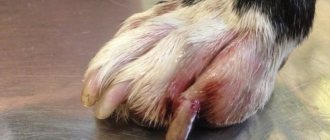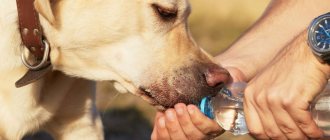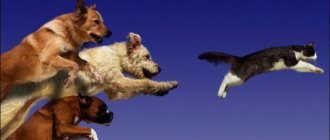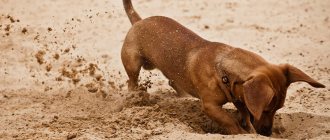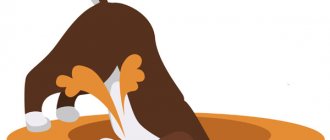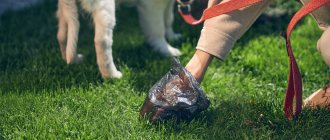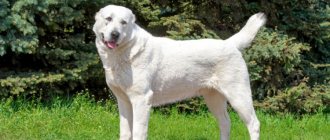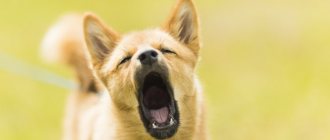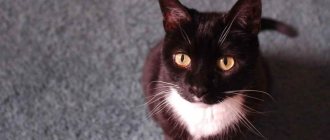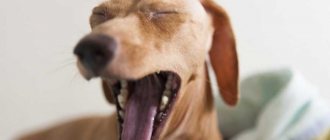Harmless reasons
This phenomenon called butt rolling is often observed in long-haired dogs after they go to the toilet.
Long hair is certainly beautiful, but, as they say, there is another side to the coin. Feces can get tangled in the fur so that you won't even see it.
But the dog will feel discomfort and will rush to get rid of the stuck trouble by wiping its butt on the floor.
Another reason is similar. The dog may be trying to clean itself, not necessarily from the stool. Perhaps the fur near the anus is stained with urine, or even some kind of foreign substance.
The point is that dogs are quite clean, and if they cannot lick themselves somewhere, then they look for another way, for example, wiping them on the walls or floor.
There is a way out of this situation - a hygienic haircut. You can do this yourself if you have a certain skill, or take your pet to a groomer.
Helminthiasis
If the owner does not regularly treat the pet for helminths, parasites can settle in the intestines. When there is a large accumulation of worms, they can clog the intestines and come out through the anus, causing irritation of the anus. The dog scratches it, crawling with its heel on the floor or ground.
Infection with worms can be suspected by weight loss, alternating constipation and diarrhea, deterioration in coat quality and the presence of blood in the stool. Sometimes worms can be seen in feces.
Important!
To eliminate parasites, anthelmintic treatment should be carried out at least once every three months.
When “riding on the butt” is a symptom of problems with the body
There are many reasons behind this behavior in a dog. If you pay attention to this in time and take care of the problem, then nothing will threaten the life of your pet.
But any of the following pathologies will cause great discomfort and have serious consequences for the dog’s life if they are not addressed.
Don't turn a blind eye to this symptom.
Paraanal glands
These are glands whose secretion has an individual specific odor. With their help, dogs mark their territory. They are located at the exit to the anus, and their ducts open into the rectum.
Thus, the contents of these glands are released along with feces during bowel movements. Normally, they do not make themselves felt in any way; many dog owners do not even know about the existence of these glands.
However, due to improper feeding or simply due to the characteristics of the dog’s body, the anal sacs can become clogged and inflamed.
The owner needs to learn how to clean the pet's anal glands, or seek the help of a veterinarian.
How to understand that the glands are inflamed:
- The dog feels severe discomfort in the anal area - itching mixed with pain. This is what causes riding on the butt.
- Swelling appears around the anus. You can even feel dense formations - these are clogged glands.
- The dog does not allow you to touch its butt and may behave aggressively.
If no measures are taken, the pet will suffer, and the consequences will be serious, including paralysis of the rear part of the body or peritonitis.
To avoid this, you need to periodically clean these glands.
Anal gland problems are very common in small and miniature breed dogs.
When should you take your animal to the doctor?
Urgent medical attention is required when bleeding and nodular formations appear, but in all other cases it is also recommended to make an appointment at a veterinary clinic. Only there will they be able to make an accurate diagnosis and prescribe effective treatment.
Taking anthelmintics can lead to massive death of parasites with subsequent poisoning of the body with toxins. This can worsen your pet's condition, so it is best to discuss taking anti-worming tablets or suspensions with your veterinarian.
The abscess is opened surgically. During the operation, the animal's pus is removed and the wound is washed with saline solution. With a perianal fistula, the glands have to be cut out and antibiotics used.
Intestinal diseases are treated with a special diet, laxatives, rectal suppositories, antibiotics and anti-inflammatory drugs. The operation is performed only in particularly severe cases that threaten the life of the four-legged patient.
Treatment
In most of the cases described, you cannot do without the help of a veterinarian.
If you don’t see any other symptoms of illness, then the best way to prevent this is a hygienic haircut.
If your dog has one of the above pathologies, then in addition to visiting a doctor, you will need to change your pet’s diet, feed it softer food or special food.
Under no circumstances should you feed your dog bones!
Also, if your dog’s anal glands are periodically clogged, so as not to take him to the veterinary clinic every time, you can learn how to clean them yourself.
But it is better to do this after consulting a doctor.
To make sure it's time for cleaning, you need to check the filling of the glands. To do this, you must palpate the glands from the inside.
Put on gloves, take Vaseline and insert your finger into the anus. Inject shallowly; if the glands are clogged, you will immediately feel a compaction. If everything is soft, then be sure that everything is fine with the dog.
The cleaning process is extremely unpleasant for a dog, therefore, for your safety, secure your pet well and wear a muzzle:
- You will need bandages or just a bandage, a chlorhexidine solution and a treat to calm your dog.
- It will be difficult for you alone; ask someone to hold the animal.
- Lift the tail with one hand and grab the bandage with the other. Using two fingers (thumb and index finger), pinch the sides of the anus. With your fingers you will just feel the anal sacs.
- Squeeze the hole on both sides, as if squeezing out the contents of the bags. If everything is correct, then you will see a viscous secretion of an unpleasant odor, beige or grayish in color, coming out of the glands.
- After this, moisten another cloth with chlorhexidine and wipe around the hole.
- Give the dog a treat for not eating you.
Help at home
You can clean the anal glands on your own. This procedure is very unpleasant, since the odorous secretion can stain not only surrounding objects, but also the owner. For the safety of your pet, it is better to take it to the bathroom, remembering to dress in old clothes and latex gloves.
It is recommended to carry out the procedure with an assistant, since due to unpleasant sensations the dog will break free and interfere with the process. In addition to one more person and protective clothing, you will need napkins, Vaseline and a basin. After completing the preparatory actions, you must:
- Position the dog in the bathtub by lifting his tail and placing a basin under his anus. A pet with modest dimensions can be cleaned directly in the basin.
- Find two lumps by palpating the anus.
- Use Vaseline to lubricate the anus and gently squeeze the seals, remembering to place a napkin under them.
- Wash your pet after the last drop of secretion comes out and lubricate his anus again.
If the secretion does not come out, consult a doctor. This is typical for difficult cases, so increased compression can harm the animal.
Detected wounds and abrasions must be treated with antiseptics to prevent the development of infection. Similar actions will be needed when opening an abscess. If the abscess breaks out without your participation, treat the wound with chlorhexidine, put ichthyol ointment in it, apply a bandage and go to the veterinary clinic.
In case of frequent intestinal disorders, it is recommended to change the food or make sure there is enough fiber in the natural diet. If pieces of feces get stuck due to long hair, trim the animal in the problem area. After a hygienic haircut, the situation will go away by itself.
Popular questions
A dog rides on its butt after a haircut, why?
Going to the groomer is stressful for a dog. And stress can cause itching.
Another reason is that your pet may be allergic to one of the products used during washing and grooming.
Why does a dog slide its butt on the carpet?
There are two conditions when a dog can do this - it itches in the butt area and feels discomfort, or it is trying to cleanse itself.
Why does a dog ride on its butt on the ground?
The reasons are still the same, only here it is less likely that she is trying to cleanse herself. Most likely, she was overtaken by severe itching.
Inflammation of the paraanal glands
This disease is treated by cleansing the sinuses, as well as rinsing in a sterile solution. If you can perform the first part of the procedure yourself at home, then for washing with a sterile solution you will have to go to the veterinarian for a week.
Diet and prevention of inflammation of the paraanal glands in dogs
This procedure is called surgery and for some breeds it is performed under local anesthesia.
The animal is given a sedative that calms the dog and relaxes the muscles. If doctors are faced with a large affected area, then within a month they will use antibacterial agents that will be applied to the operated area.
Also, the animal will have to walk in a sling for some time, and a special collar will be put on the dog in order to protect it from injury.
Briefly about the main thing
- There are many reasons why a dog rides on its butt; they can be harmless, or they can indicate problems with the body.
- The harmless reason is “original cleaning”. The pet's butt area may be dirty, and this is how it tries to clean itself.
- Signal of pathology - if accompanied by itching, sometimes pain, formations around the anus, inflammation and other symptoms.
- List of pathologies that occur: blockage of the paraanal glands, helminthic infestation, abscess, fistula, coprostasis, rectal prolapse (rectal prolapse).
- You can learn to clean the anal glands yourself so as not to start this process.
- To prevent such pathologies, it is necessary to feed the dog correctly and in a balanced manner and promptly treat it from external and internal parasites.
Have we answered your question fully enough? If not, post your question in the comments below and our veterinarian will answer it.
Did you like the article? Share it with your friends on social media. networks. This will help them get useful information and support our project.
Intestinal diseases
A dog can roll on its fifth point with some pathologies of the gastrointestinal tract. These include:
- colitis – inflammation of the colon, which can be caused by poor diet, chronic gastrointestinal diseases, helminthiases, foreign objects entering the intestines and even stress;
- hemorrhoids are a pathology of the veins. Dilatation of venous vessels can occur due to poor nutrition, obesity, hormonal disorders, too low or, conversely, too high physical activity of the dog;
- enterocolitis is an inflammatory process in the intestine that affects not only the large but also the small intestine.
The diseases differ in their characteristic symptoms (this may include constipation, bloody stools, vomiting, increased gas formation, acute abdominal pain, gray coating on the tongue, unpleasant odor from the mouth, and others) and require mandatory treatment under the supervision of a specialist.
Manifestations of anxiety
It’s easy to notice that something is bothering your pet. The dog may become irritated and capricious, actively scratch or lick sore areas, try to retire or, conversely, even more actively seek support from the owner, shows aggression when they try to pet it, does not want to go for a walk or eat, tries to roll on the floor in order to alleviate the state of irritation. skin.
Although not all pets outwardly show signs of anxiety. However, papules, peeling, scabs and various redness may be found on their skin. After scratching, all this turns into bleeding wounds, which the dog constantly licks and scratches, and if he cannot reach them, he constantly whines. These reactions may not appear immediately, but after a day or two.
List of medicines for itching
Self-prescription of antipruritic drugs is strictly prohibited! Itching is primarily an external manifestation of the problem. If it is masked, then the main pathology that provokes it will progress, causing irreparable harm to the health of the animal!
Below is a list of medications that have a pronounced antipruritic effect and are used by veterinary specialists if the pet itches severely and frequently. Be sure to take into account the underlying pathology (the information is given for informational purposes only and cannot be taken as a guide to action without consulting a specialist):
- Oclacitinib (Apoquel).
- Glucocorticosteroids (Metypred, Dexa-kel, Dexa-fort, Stop-Itching, Kenalog, Polcortolon, Diprospan, Execan).
- Cyclosporine (Atopica).
- Psychotopic drugs (Gabapentin, Topiramate, Pregabalin).
- Antihistamines containing chlorpheniramine, diphehydramine, hydroxyzine, cetirizine, etc. (Diphenhydramine, Chlorphenamine, Atarax, Cetrin, Zyrtec, Clemastine, Tavegil).
- Pentoxifylline.
- Symptomatic therapy (antibiotics, fungicides, antispasmodics, vitamins, etc.).
- Omega-3,6 fatty acids (5:1).
The drugs are used strictly in veterinary dosages!
Survey
The first thing the veterinarian does during a proper examination is to clarify the history of treatment for worms and carefully check for the presence of fleas. Diagnosing worms can be a little tricky upon examination unless the infestation is severe and there are no adult worms or tapeworm segments visible in the feces or lodged in the fur around the anus. If a specialist has determined that worms are the problem causing the symptoms, the dog is simply treated with a high-quality product in the correct dosage.
Irritation and itching in dogs after a haircut: what is the reason for this?
Grooming is one of the mandatory procedures that allows you to keep your pet’s appearance well-groomed, attractive and stylish. Also, manipulation allows you to get rid of bacteria, microbes, fungi located in the animal’s fur.
However, often after this procedure, pet owners complain of irritation and explain the phenomenon by the incompetence of the specialist, poor hygienic conditions, and poor sanitary standards. Is it so?
Signs
There are many reasons why irritation or itching occurs after a haircut. Signs:
- Licking the inflamed area.
- Aggression, irritability.
- Fever.
- Solitude or excessive activity.
- Refusal to go for a walk.
- Poor appetite.
When the owner runs his hand over the inflamed area, the animal may make a squeak or other sounds, or it will be impossible to touch or stroke it at all. At the site of irritation, redness, small ulcers or abscesses, papules occur, and the skin begins to peel off.
Having discovered such a place, it is not recommended to scratch it - this will lead to the formation of wounds or bleeding.
Causes
Among the main reasons are:
- Stress.
- Physiological abnormalities.
- Unsuitable cosmetics.
- Reaction to the machine (alloy of knives in contact with the skin).
- Rare frequency of haircuts.
- Poor handling of tools.
If the pet is a long-haired breed, then groomers are faced with a problem such as mats. Scratching them introduces additional germs, leading to irritation and itching.
Help
Having discovered one of the symptoms, it is important not to ignore the problem, but to help your pet. Your actions:
- Call the specialist who cut your pet's hair.
- Statement of the situation, explanation of the dog’s behavior, symptoms.
- If the itching is severe, give your pet sedatives.
- Treat the inflamed area with an antiseptic, but make sure that he does not lick it off.
If after 4-5 days the situation does not improve, it is recommended to contact a veterinarian.
Closed abscess
If a dog has an abscess, it is surgically opened at the veterinarian's office and cleaned out. When washing, only saline solution and a disinfectant are used. Most often, doctors use Cephalexin.
An example of a closed abscess in a dog
And if the abscess is extensive, the animal will be given a drainage, which will facilitate the outflow of fluid and suppuration. The doctor may suggest you administer an ointment that contains an antibiotic. At the same time, the animal is given injections with antibiotics. This is Amoxicillin or hyaluronic acid.
If a serious complication occurs, which characterizes an advanced case, removal of the anal sinuses will be required.
What to do
As soon as the owner notices any irritation, he should call the professional who groomed the dog and inform him about it. The groomer will be able to take additional measures to avoid infecting other clients if the cause is some kind of disease.
If the dog begins to actively itch and thus can increase irritation, then he needs help. In such cases, it is impossible to let everything take its course, since ulcers will soon appear, which then turn into wounds, which can be joined by a bacterial infection. This can even end in sepsis and death of the animal.
If the itching is too strong and it is not possible to prevent scratching by simply distracting the pet, then you can give a sedative for several days. You need to choose a safe drug that will allow you to sleep normally and curb your dog’s activity.
Sometimes it is advised to play with your pet more often these days, go for walks, so that the animal is distracted and constantly occupied with something. This will allow you to forget that your body itches.
To reduce discomfort, you should treat the inflamed areas with an antiseptic solution such as Miramistin, Chlorhexidine, and then lubricate the skin with ointment or softening cream - Sudocrem, Bepanten, Boro-plus. Sometimes it is recommended to use tea tree oil or baby cream.
When applying any of these products, you need to monitor your pet's reaction because in rare cases they can cause a burning sensation. The main thing is not to let the applied products be licked from the skin. Sometimes you can use the recommendation to take antihistamines, which will help relieve inflammation and reduce itching. After 3-4 days the situation should recover.
If the inflamed areas of the skin begin to become covered with crusts, there is a high probability of fungal flora joining, so the dog should be shown to a veterinarian.
